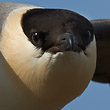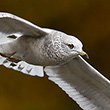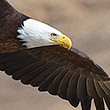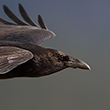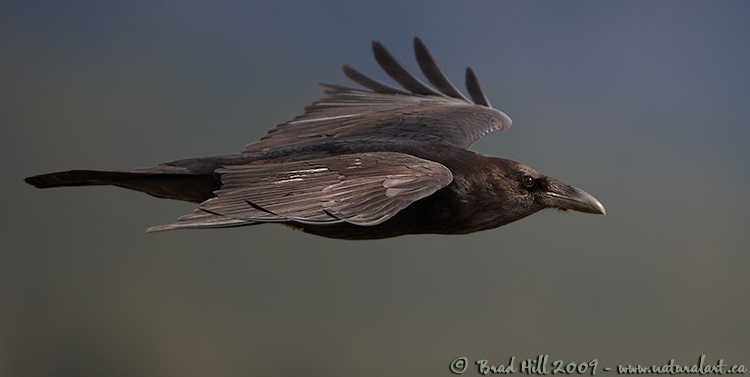
Availability: Undetermined - Enquiries?
In the Field
Soaring Songbird. Ritchey's Point, Wilmer, BC, Canada. March 28, 2009.
Bird flight is an absolutely amazing thing. Even if you ignore the almost countless physical and physiological adaptations that make it possible, the neural control of the behaviours and subtle motor skills (such as the continual minor wing/feather adjustments needed to cope with changing wind currents) is mind-boggling. I captured this image while perched atop a high cliff waiting for migrating eagles to drift by. I noticed the raven slowly drifting up the cliff face (towards me) and temporarily shifted to a new "target". Even though the raven was close and filled a major portion of my viewfinder, initially my autofocus system struggled to find enough contrast to "lock on" to the subject - luckily it snapped into focus just as the raven drifted by at eye-level.
Ravens are the largest of our songbirds (Order Passeriformes) and command deep respect among many of our indigenous cultures. But, based on how common they are but how seldom you see photos of them, they don't seem to be quite as highly regarded by many nature photographers - and they're rarely the subject of flight shots. I think the reason is simple - they're darned hard to photograph! In most cases ravens "register" as completely black and featureless to our eye (like a silhouette), especially when flying. Capturing the "dark-on-dark" detail requires both "good" light and a carefully controlled exposure. In this case the light was near perfect to show the subtle browns, blues, and even magentas in the raven's plumage - it even allowed me to capture the brown tones (not black!) of the iris (hard to see in this small web-version of the image, but very noticeable on the full-res version). By the way - the green-to-blue transition in the out-of-focus background is actually a transition from a pine/Douglas Fir forest (the greens) to distant mountains (which are commonly blue to the eye).
I'm often asked about how to determine the "correct" exposure for capturing birds in flight. While it would be fun to pretend there's some magic (and very secret) formula, the truth is that it's no different from shooting any other subject. I use Nikon's "matrix" metering exclusively (Canon's equivalent is referred to as "Evaluative" metering) - it's highly accurate and rarely more than 1/2 stop or so "off". If you combine matrix metering with the feedback of the two primary exposure aids of modern digital cameras (the histogram and the blinking "highlight warning" display) you'll soon gain the knowledge and experience to hit the exposure right in most instances.
But - and here's the bad news - you do still have to think, and often you have to do it very fast! This image is a good example of the type of thinking you need to apply to your exposure decisions. Normally when you photograph a dark bird it's against a lighter background (especially when in flight) and it's REAL easy to under-expose the bird (and lose all the black-on-black detail). So...the first reaction is to over-expose the image (add positive compensation). However, in this case, the bird was against a relatively dark background (largely because I was shooting level and not pointing my camera up into the sky) AND the dark bird filled a large portion of my viewfinder. This meant my "smart" matrix metering already "knew" the subject should be exposed more. And, there were bright highlights on the bird's beak and forehead which could have been easily over-exposed (and blown-out). So, instead of over-exposing this dark bird, I actually UNDER-EXPOSED the image compared to the matrix-metered exposure "suggestion" of the camera. The under-exposure was minor (-0.3 of a stop) but it saved those critical highlights.
Behind the Camera
Soaring Songbird. Ritchey's Point, Wilmer, BC, Canada. March 28, 2009.
Digital Capture; Compressed RAW (NEF) 14-bit format; ISO 450.
Nikon D3 with AF-S Nikkor 600mm f/4G IF-ED II VR lens supported on Gitzo 1348 carbon fibre tripod with Wimberley head. VR turned to "On" and in "Normal" mode. Autofocus set to M/a mode.
1/1250s @ f4; -0.3 stop compensation from matrix-metered exposure setting (to preserve highlight details on beak and forehead).
At the Computer
Soaring Songbird. Ritchey's Point, Wilmer, BC, Canada. March 28, 2009.
RAW Conversion to 16-bit TIFF, including first-pass/capture sharpening using Phase One's Capture One Pro 4.6.2. Three RAW conversions at different exposure settings: -0.75 stops for background and near wing "top"; 0 for most of raven; +0.25 for neck and throat region.
Further digital corrections on 16-bit TIFF file using Adobe's Photoshop CS4. Adjustments included compositing and masking of 3 exposure versions, selective colour saturation, selective curves adjustment, and selective sharpening for web output.
Conservation
Soaring Songbird. Ritchey's Point, Wilmer, BC, Canada. March 28, 2009.
Ten percent of the revenue generated by this image will be donated to Wildsight.
Species Status in Canada*: This species is not designated as at risk.
The majestic Common Raven (Corvus corax) has an extremely broad geographic and ecological distribution - its natural distribution is one of the widest in the world. One factor contributing to this wide distribution is the huge range of foods (and feeding behaviour) of the raven - it's a scavenger, predator AND kleptoparasite. Its diet includes carrion, large numbers of arthropods, small rodents, bird nestlings, seeds, grains and more.
This Common Raven was photographed in the Columbia Valley of the East Kootenays. While Ravens are not considered at threat, many ecosystems within the Columbia Valley face development pressure. Wildsight is an effective conservation organization that protects biodiversity and promotes sustainable communities in Canada's Columbia and Rocky Mountains. Support for Wildsight, through donation or becoming a member, will help ensure that they remain effective in their efforts to conserve threatened or endangered species and ecosystems.
*as determined by COSEWIC: The Committee on the Status of Endangered Wildlife in Canada





















